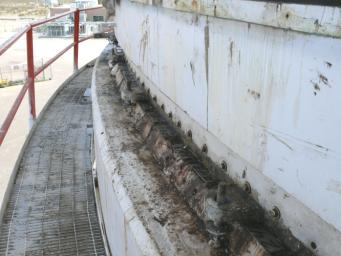
|
Out with the Old Grout
- Click the image above for a larger view
- Full-Res JPEG (2560 x 1920) (609.2 kB)
- Full-Res TIFF (2560 x 1920) (14.8 MB)
Caption:
This image, taken on March 22, 2010, shows the condition of grout that was replaced in the giant "Mars antenna" at the Deep Space Network's Goldstone, Calif. complex.
The grout is part of the hydrostatic bearing assembly, which enables the antenna to rotate sideways. It supports a ring that is about 24 meters (80 feet) in diameter and made of 11 segments of steel. About 3 million kilograms (7 million pounds) float on a thin film of oil as the upper part of the antenna rotates.
After decades of constant use, oil seeped through the joints into the cement-based grout and degraded the structural integrity of the grout. Shims, the flat pieces of metal visible on top of the grout in this picture, were adjusted to keep the runner flat. Rather than continuing on a weekly schedule to adjust the shims, Deep Space Network managers decided to replace the whole runner assembly.
The major refurbishment lasted from March to October 2010. They poured a new kind of epoxy grout, put in a new steel runner and completed a number of maintenance tasks.
The 70-meter-wide (230-foot-wide) Mars antenna first went into service in 1966.
It got its nickname from its first task: tracking the Mariner 4 spacecraft after its historic flyby of Mars. The antenna's official name is Deep Space Station 14.
Background Info:
JPL, a division of the California Institute of Technology in Pasadena, manages the Deep Space Network for NASA Headquarters, Washington. More information about the Deep Space Network is online at http://deepspace.jpl.nasa.gov/dsn/index.html .
Cataloging Keywords:
| Name | Value | Additional Values |
|---|---|---|
| Target | Earth | Mars |
| System | ||
| Target Type | Planet | |
| Mission | Deep Space Network (DSN) | Mariner |
| Instrument Host | Goldstone Deep Space Communications Complex (GDSCC) | |
| Host Type | Ground-Based Observatory | Flyby Spacecraft |
| Instrument | Deep Space Station 14 | Goldstone Solar System Radar |
| Detector | ||
| Extra Keywords | Color, Radar, Radio, Rotation | |
| Acquisition Date | ||
| Release Date | 2010-11-03 | |
| Date in Caption | 2010-03-22 | |
| Image Credit | NASA/JPL-Caltech | |
| Source | photojournal.jpl.nasa.gov/catalog/PIA13564 | |
| Identifier | PIA13564 | |
